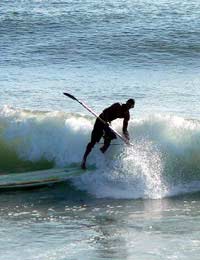The Reality of 'Surf Rage'

Media may have been duped into believing a UK surfing resort was being subjected to a campaign of ‘surf rage’ but was the story so believable because there was some truth to it?
Locals Only!
2004 saw a wave of alarming reports by national media about a campaign of ‘surf rage’ in Portreath in Cornwall that was threatening to “cripple the thriving local tourism on which the town survives.” The story centred on a gang of vigilante Cornish surfers that were hell bent on confronting visitors with ‘guerrilla tactics’ and had daubed ‘Locals Only!’ in intimidating letters across the small town’s sea wall as a warning.The reports seemed to bear out concerns that the increased popularity and commercialisation of surfing in the UK over the previous few years, that has seen a massive influx of out-of-town surfers descend on Britain’s surf hot spots, could provoke a fierce backlash from the sport’s staunch local enthusiasts.
Although the story turned out to be a hoax conceived by a mischievous band of marketing and journalism students keen to carve out career opportunities, what made it believable was that it did have a disturbing truth at its core, only it was Australian and not British surf resorts that had been subject to outbreaks of surf rage.
Australian Surf Problem
The Portreath hoaxers likely found their inspiration down under where surf rage had begun to spark very real safety concerns. In one extreme case a campaign of intimidation waged against other surfers led to one Sydney surfer facing 29 police charges and a ban from all city beaches.The chief provocation for heated exchanges on the beaches is congestion in the waters of popular resorts that has meant more people riding waves and, as a consequence, an increased potential for getting in one another’s way. More specifically, one particular source of rage has been the local resentment towards novices and tourists invading their territory without due knowledge or concern for surfing etiquette.
Attempts to tackle the problem have included specialist training for lifeguards faced with warring beach users and, as in the landmark case of Manly Beach in Sydney, the introduction of signs detailing the correct protocol for surfers.
Surfing Etiquette
As one of Australia’s most popular surfing beaches and tourist destinations, it’s perhaps not surprising that Manly has proven to be one prime hotbed of surf rage. In an effort to quell the outbreaks of unrest, its local council decided to erect signs detailing a list of rules for surfers, the first to do so in the Sydney area.Primarily aimed at visitors and beginners, the surfboard-shaped signs inform surfers about avoiding offences such as ‘dropping in’ – where a surfer ignores another’s right of way on a wave by surfing on it themselves – or ‘snaking a wave’, where they queue jump by swimming around another surfer. The signs also encourage surfers to wait politely and also inform their neighbours about which direction they intend to move in.
By and large the new signs were welcomed by the public as a positive means of diffusing heated confrontations. If a surfer dropped in on another surfer, for instance, the victim could then point the offending party in the direction of the rules rather than be forced to dish out their own less civilised brand of instruction.
Nevertheless, some locals criticised the signs as further evidence of Australia’s move towards becoming a ‘nanny state’.
A Warning
As Australia has a much more developed and ingrained surfing culture than Britain it is perhaps not surprising that the UK has yet to experience surf rage outside the pages of its more gullible broadsheets. But as the UK surf industry continues to grow the possibility that we will begin to see the emergence of some of the troubling characteristics already seen down under grows stronger - not least because the seeds of discontent already exist.In the surfing resorts of the West Country there is believed to be genuine antagonism between local surfers and visitors that could easily blossom into more visible signs of ill feeling. If the local-visitor relations do deteriorate then, just as the hoaxers did, the authorities faced with finding a solution are advised to look to Australia for inspiration.







